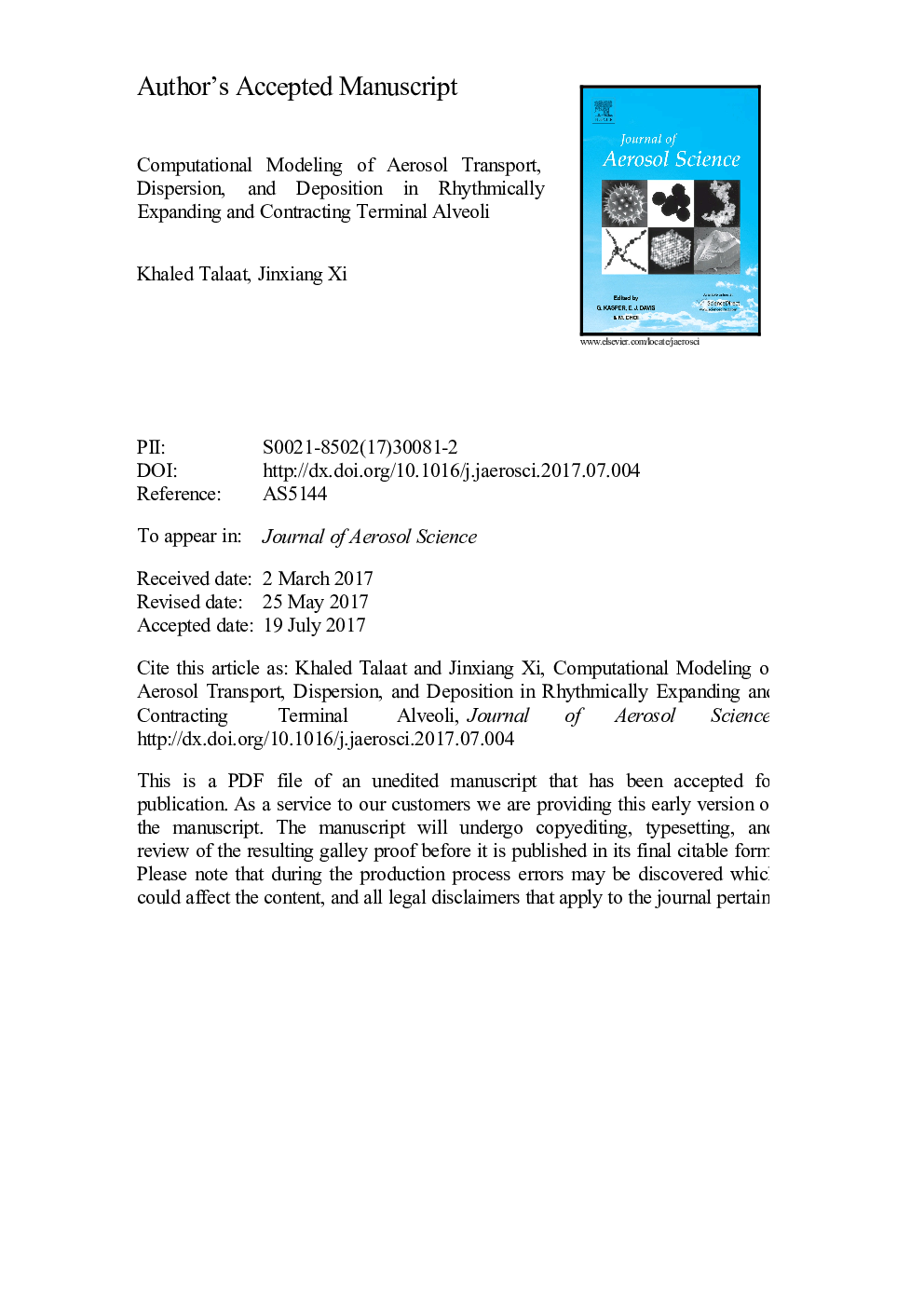| کد مقاله | کد نشریه | سال انتشار | مقاله انگلیسی | نسخه تمام متن |
|---|---|---|---|---|
| 5753841 | 1620711 | 2017 | 39 صفحه PDF | دانلود رایگان |
عنوان انگلیسی مقاله ISI
Computational modeling of aerosol transport, dispersion, and deposition in rhythmically expanding and contracting terminal alveoli
ترجمه فارسی عنوان
مدل سازی محاسباتی حمل و نقل، پراکندگی و رسوب آئروسل در آلوئولهای ترمینال گسترش یافته و پراکنده ریتمیک
دانلود مقاله + سفارش ترجمه
دانلود مقاله ISI انگلیسی
رایگان برای ایرانیان
کلمات کلیدی
آلوئولوس ترمینال، کانال آلومینیومی، پراکندگی ذرات، منطقه آیسینار، گسترش ریتمیک و انقباض، اسپری بولوس،
ترجمه چکیده
دوزیمتری استنشاقی در منطقه آلوئولار در ارزیابی خطرات سلامت سموم استنشاقی و نتایج درمانی تحویل داروهای سیستمیک ریه بسیار مهم است. اکثر مطالعات قبلی در مورد رسوب آکینار بر روی برونشوی تنفسی یا مجاری آلوئولیا متمرکز شده اند که جریان هر دو طرفه یا منحنی دائمی را از طریق کانال ثابت می کند. ماهیت دقیق دینامیک ذرات در پاسخ به حرکات دیوارهای مختلف نواحی نابالغ نابالغ مشخص نیست. هدف این مطالعه، بررسی عددی رفتار و رفتار ذرات در آلوئول ترمینال است که به شکل ریتمیک گسترش و قراردادن در حالت ها، فرکانس ها و دامنه های مختلف می باشد. مطالعه پارامتریک از عوامل فیزیولوژیکی که تحت تاثیر رسوب آلوئولار قرار می گیرند، برای درک بهتر مکانیزم های مربوط به رسوب سازی انجام می شود. پراکندگی ذرات و اثر دیوار ریتمیک بر رسوب آلوئولار در غیاب گرانش بررسی خواهد شد. مدل آلوئولوس ترمینال ایده آل شده با شرایط مرزی حرکتی آلوئولار به صورت ریتمیک طراحی شده است. حالت و اندازه گسترش دیوار پویا بر مبنای حرکات دیوار قفسه سینه و حجمهای جزر و مدی آزمایش شده است. تجزیه و تحلیل ابعاد برای ایجاد یک همبستگی رسوب آلوئولی انجام شد. نتایج این مطالعه اختلافات رادیکال در سینتیک جریان هوا را در مقایسه با مجرای آلوئولایی نشان می دهد. مناطقی که گردش هوا را در کانال آلوئولیتال مشخص می کنند، در انتهای آلوئول وجود ندارد. این مطالعه همچنین نشان می دهد که رسوب آلوئولار حساس به قطر ذرات، جهت گیری آلوئولار و فرکانس نفس است، اما نسبت به عمق تنفس نسبتا حساس است. حرکت دیوار دوره ای آلوئولار منجر به پراکندگی ذرات افزایشی می شود که اثرات خالصی در کاهش رسوب ذره در آلوئول دارد. همبستگی برای رسوب ذره در آلوئولهای ترمینال پیشنهاد شده است که سهم جداگانه از رسوب گرانشی و حرکت دیوار ریتمیک را به دست آورد.
موضوعات مرتبط
مهندسی و علوم پایه
علوم زمین و سیارات
علم هواشناسی
چکیده انگلیسی
Inhalation dosimetry in the alveolar region is critical in assessing health risks of inhaled toxicants and therapeutic outcomes of systemic pulmonary drug delivery. Most previous studies of acinar deposition focused on respiratory bronchioles or alveolated ducts with either steady unidirectional or tidal flow through the duct. The precise nature of particle dynamics in response to different wall motions of the blind-ended terminal alveoli is unclear. The objective of this study is to numerically investigate the flow and particle behaviors in terminal alveoli which rhythmically expand and contract at varying modes, frequencies, and amplitudes. Parametric study of physiological factors that affect alveolar deposition will be undertaken to gain a better understanding of relevant deposition mechanisms. Particle dispersion and rhythmic wall effect on alveolar deposition will be examined in the absence of gravity. An idealized terminal alveolus model was developed with rhythmically alveolar moving boundary conditions. The dynamic wall expansion mode and magnitude were based on experimentally measured chest wall motions and tidal volumes. Dimensional analysis was used to develop an alveolar deposition correlation. Results of this study show radical discrepancies in airflow kinetics in comparison to the alveolated duct. Recirculation zones that characterize the airflow in the alveolated duct are absent in the terminal alveolus. This study also demonstrates that the alveolar deposition is sensitive to the particle diameter, alveolar orientation, and breathing frequency, but is relatively insensitive to the breathing depth. The periodic alveolar wall motion leads to incremental particle dispersion, which was found to have a net effect in reducing particle deposition in the alveolus. A correlation was proposed for particle deposition in terminal alveoli that captured the separate contributions from the gravitational sedimentation and rhythmic wall motion.
ناشر
Database: Elsevier - ScienceDirect (ساینس دایرکت)
Journal: Journal of Aerosol Science - Volume 112, October 2017, Pages 19-33
Journal: Journal of Aerosol Science - Volume 112, October 2017, Pages 19-33
نویسندگان
Khaled Talaat, Jinxiang Xi,
